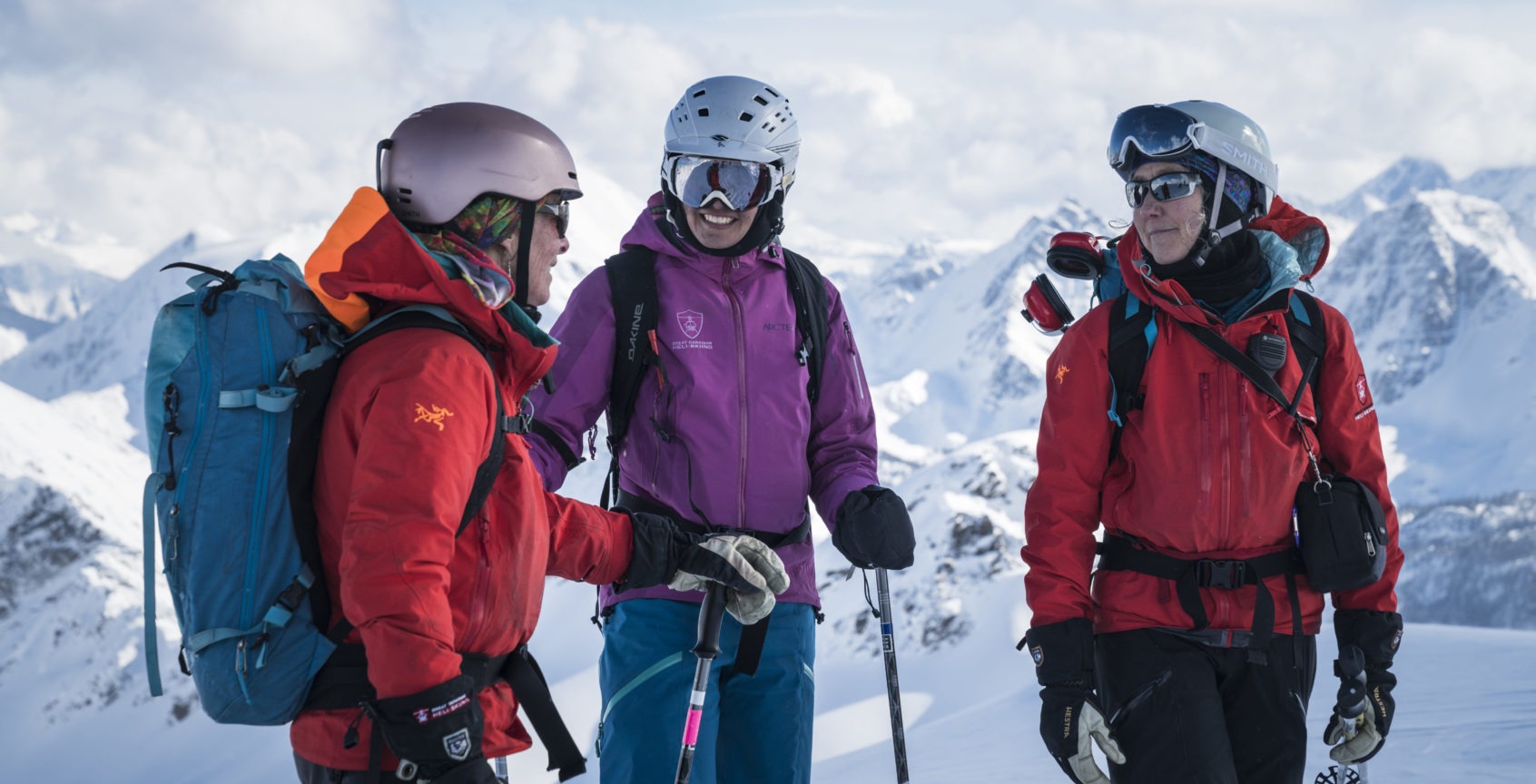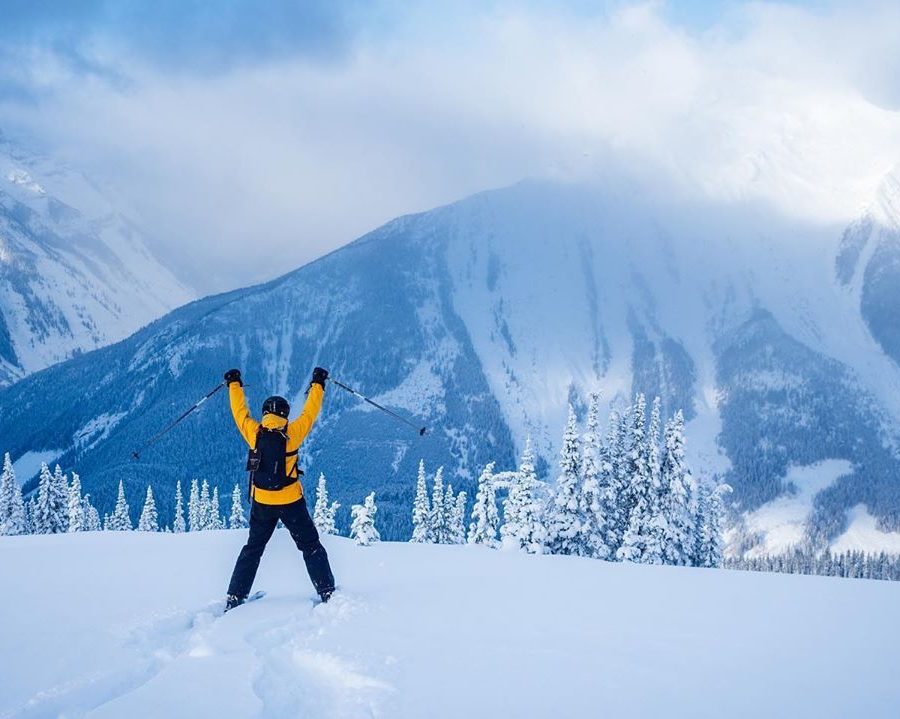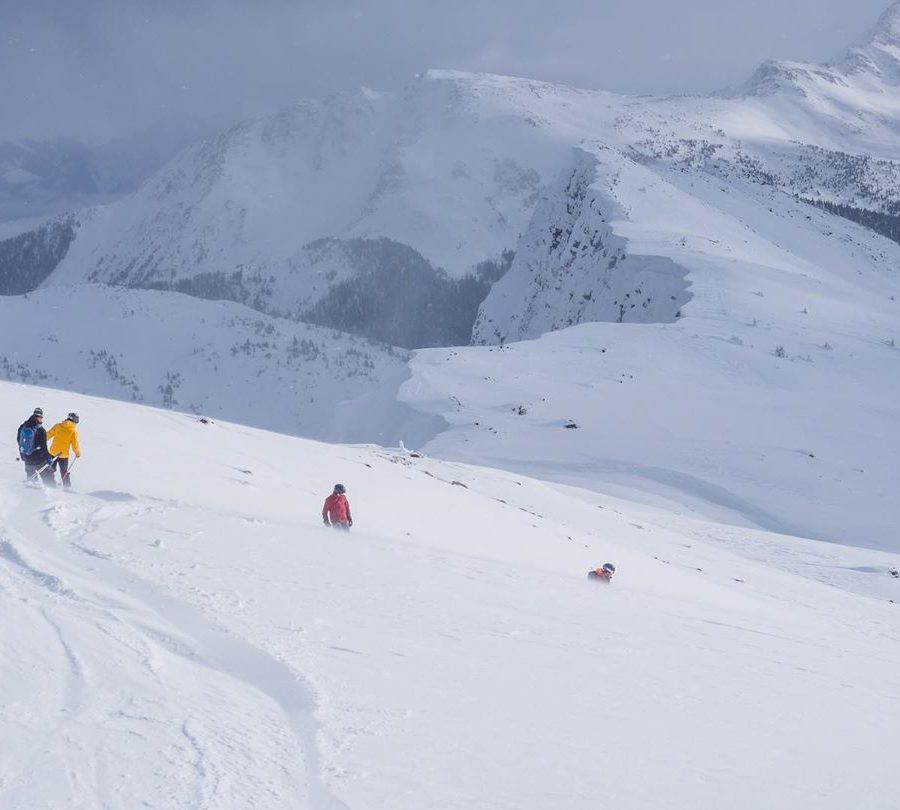Maaike Porter is the owner and CEO of Great Canadian Heli-skiing (GCH). Sue Gould is the first female board member of HeliCat Canada, the country’s association of helicopter and snowcat skiing industries. She’s also GCH’s Director of Guide Operations, making the leadership team 50% women. Sylvia Forest, one of the company’s long-time guides, is the first female president of the Association of Canadian Mountain Guides.
This gathering of standout leaders at the top of a stunning ski run is just another day in winter at GCH, which has been normalizing women’s participation in the ski industry for decades. The only thing abnormal about this instance is the fact that all three women are actually skiing together for the first time in their 20-year relationship, celebrating International Women’s Day the best way they know how: with deep turns in the mountains on a bluebird day.
Skiing has long been a male-dominated arena. Gould is one of only 9 percent of ski-trained certified guides in the ACMG. In its US counterpart, the American Association of Mountain Guides (AMGA), 8 percent of ski guides and 6 percent of alpine guides are female. Worldwide, only 105 of the 6,937 mountain guides certified by the International Federation of Mountain Guides Association (IFMGA) are women, including Forest.
When Porter took the reins at GCH and Heather Mountain Lodge, collectively called Best Day Ever Management Group, along with her husband Greg, she became the first female CEO of a heli-ski operation. She was 25 years old. The Porters, although they were recreational skiers, hailed from an entrepreneurial background rather than from within the ski industry itself, which is perhaps why things have stood apart here from the beginning.
On the eve of International Women’s Day, as skiers congregate in Heather Mountain Lodge’s cozy lounge for happy hour drinks ahead of dinner, Porter makes the rounds between groups. She introduces herself warmly to two newcomers, women from Berlin who buzz with excitement; the next morning, they’ll finally be living their lifelong dream of heli-skiing. She high-fives a few stoked men who report they’ve just had their best day ever, something of a GCH mantra that uniquely describes not just a phenomenal ski run, but also a collection of memorable and impactful moments that all stack up to a pinnacle day. Lastly, Porter distributes hugs to a group of long-time guests who’ve become like family.
The concept of “family” is a mainstay here, a feel created in part by the hyper-personalized ski experience. GCH coined the now-popular term “boutique heli-skiing”, which means small groups of only four guests with a guide, making for an intimate day in the mountains. Much of the close-knit vibe also originates in the simple fact that the company and the lodge are family-owned and operated. The Porters, who live just down Rogers Pass in Golden, regularly bring their son and daughter up to the lodge. Gould’s husband Rob Dalinghaus is a guide here as well, and Greg and Chantelle Scroggs run operations and hospitality at the lodge. Up here, it doesn’t just feel like family. It’s literally made of families.
Over our five-star dinner, long-running guest Margot Peck tells me that her husband, an outdoor education professor, introduced Greg and Maaike on a canoe trip in Ontario. She’s been skiing at GCH since 2010, and she’s here with her children and their partners for the first time, vastly enriching the family vibe. She used to be an avid ski tourer, craving the wilderness of the backcountry. As she aged, and battled breast cancer and won, heli-skiing now gives her that wild mountain experience that touring used to provide. That’s thanks, she says, to Great Canadian’s deeply personalized ski product, with the company even going so far as to accommodate her post-surgery to get into the mountains to ski.
In those early years of her heli-skiing, Peck recalls times when she was the only woman in the lodge, a common theme in mechanized skiing. But in the last five or six years, she’s seen that steadily change. In fact, looking around tonight, we estimate that nearly half of the guests are women. Peck attributes that to Porter, who she calls “one of the most capable, brilliantly smart women” she knows, and the long-time presence of guides like Forest and Gould.
The next morning, as skiers bustle around the boot room readying gear and donning layers, guide Alison Cardinal leads a helicopter briefing for newcomers (at Great Canadian, 40% of the guide team and 55% of the lodge team are women, a nearly unheard-of ratio in this industry). As she wraps up, Forest enters to gather up the skiers for an avalanche safety training. Many of them are unaware that they’re in the presence of greatness, and Forest offers no clues other than competency and reassurance as she walks them through how beacons and probes work.
Forest was part of the first ranks of female mountain guides, the fifth woman certified in Canada. For years, she managed the prestigious mountain rescue program in Jasper National Park, and she’s one of the main architects of the Rogers Pass winter permit system that allows skiers to safely tour in one of the most complicated avalanche control zones in the world. As Forest and Gould gear up themselves to head out for their own ski day, they reminisce about completing their ski guide exam together more than two decades ago. Even then, they were normalizing the concept of women in the industry, as two of five women who completed their exam that year. That kind of concentration has never been repeated in the examination process, to their knowledge.
Out on Twilight Ridge, the excited hustle of the boot room exchanged for the solitude of snow-hushed peaks, Gould tells me that one reason fewer women tend to join the ski guide ranks is that it can be hard to mix motherhood and the demanding lifestyle of guiding. As we click into our skis, Porter and Gould agree that Great Canadian’s family ethos extends into this aspect, too, with a little help from the operation’s accessible location just up the Pass from Golden. Gould’s children are now grown, but as a young mom here, she was able to guide all day and be at home in town for dinner, homework and bedtime. Just like Porter’s do, her kids came to the lodge at all possible moments, essentially growing up in its timber-framed warmth.
Gould leads the way off the ridge, laying down perfect turns in powder that billows out behind like a snow globe. We follow her into the untouched bowl, the sawtoothed mountains outlined against an impossibly blue sky, the only sound our skis flying through snow crystals.
Pulling up next to each other at the bottom of the slope, Porter’s enthusiasm for a good run with good people on a beautiful day is undimmed by 20 years of repetition. Her love of the sport and all it represents is catching, and we carry it with us to our lunch stop with the rest of the guests.
Under the welcome sun, Alison Dakin hands out tea and sandwiches to a semi-circle of skiers. Before coming on board as a lead guide and assistant operations manager at Great Canadian, she used to own Golden Alpine Holidays, a network of ski touring huts just to the east. She jokes that she got tricked into heli-ski guiding up here. On her birthday twelve years ago, one of the then-guides at GCH called and asked if she’d like to go heli-skiing to celebrate. There was just one request: could she bring her guide pack? Since that first day leading guests through this terrain, she hasn’t looked back once.
That night at dinner, I sit next to guest Ashleigh Banfield, who’d been in Dakin’s group for the day. She cites an episode that afternoon of Dakin pulling a little saw out of her seemingly bottomless backpack, clearing a couple of small trees off the run and then hauling them out of the way for the skiers, before proceeding to lift all the backpacks and skis into the helicopter basket at the end of the run with the same energy as the first time that morning. The guides estimate it likely adds up to 1,500-2,000 pounds of lifting gear in and out of the basket in a given day of heli-skiing.
Across the dinner table, Dakin just laughs and shrugs off the amazement, and delves into the great conditions setting up for tomorrow’s runs. After all, it’s just another normal day at Great Canadian Heli-skiing.




